An Analysis of Substance Abuse and Crime in Australia Project
VerifiedAdded on 2020/03/16
|21
|2967
|43
Project
AI Summary
This project delves into the socioeconomic consequences of substance abuse on crime in Australia, focusing on both adults and juveniles. It begins by defining substance abuse and juvenile delinquency, highlighting the rise in crime rates and the negative impact on socioeconomic status. The research explores the scope of the problem, the problem statement, research objectives, and key research questions, including the causes and effects of substance abuse. Secondary sources, such as family structure and labeling theory, are analyzed to understand the factors contributing to juvenile delinquency. The methodology involves frequency tables, primary data collection through questionnaires, and stratified random sampling to gather data from a target population of 200 people. The collected data is organized and analyzed to determine the causes of substance abuse, its effects, and the demographics of the respondents. Findings reveal that income, unemployment, parental influence, and peer pressure are significant factors. The project concludes with a discussion and analysis of the data, drawing conclusions about the relationship between substance abuse and crime in Australia.
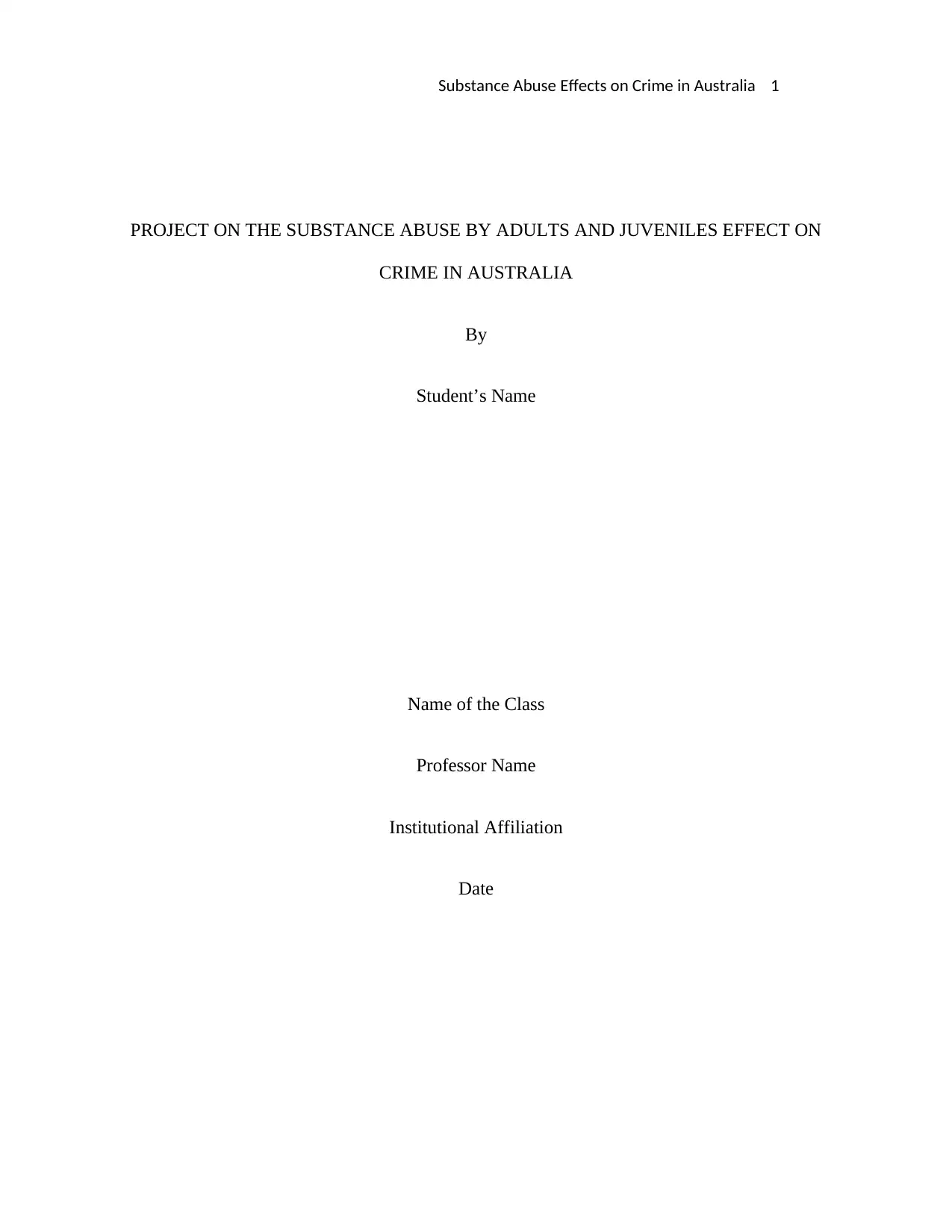
Substance Abuse Effects on Crime in Australia 1
PROJECT ON THE SUBSTANCE ABUSE BY ADULTS AND JUVENILES EFFECT ON
CRIME IN AUSTRALIA
By
Student’s Name
Name of the Class
Professor Name
Institutional Affiliation
Date
PROJECT ON THE SUBSTANCE ABUSE BY ADULTS AND JUVENILES EFFECT ON
CRIME IN AUSTRALIA
By
Student’s Name
Name of the Class
Professor Name
Institutional Affiliation
Date
Paraphrase This Document
Need a fresh take? Get an instant paraphrase of this document with our AI Paraphraser
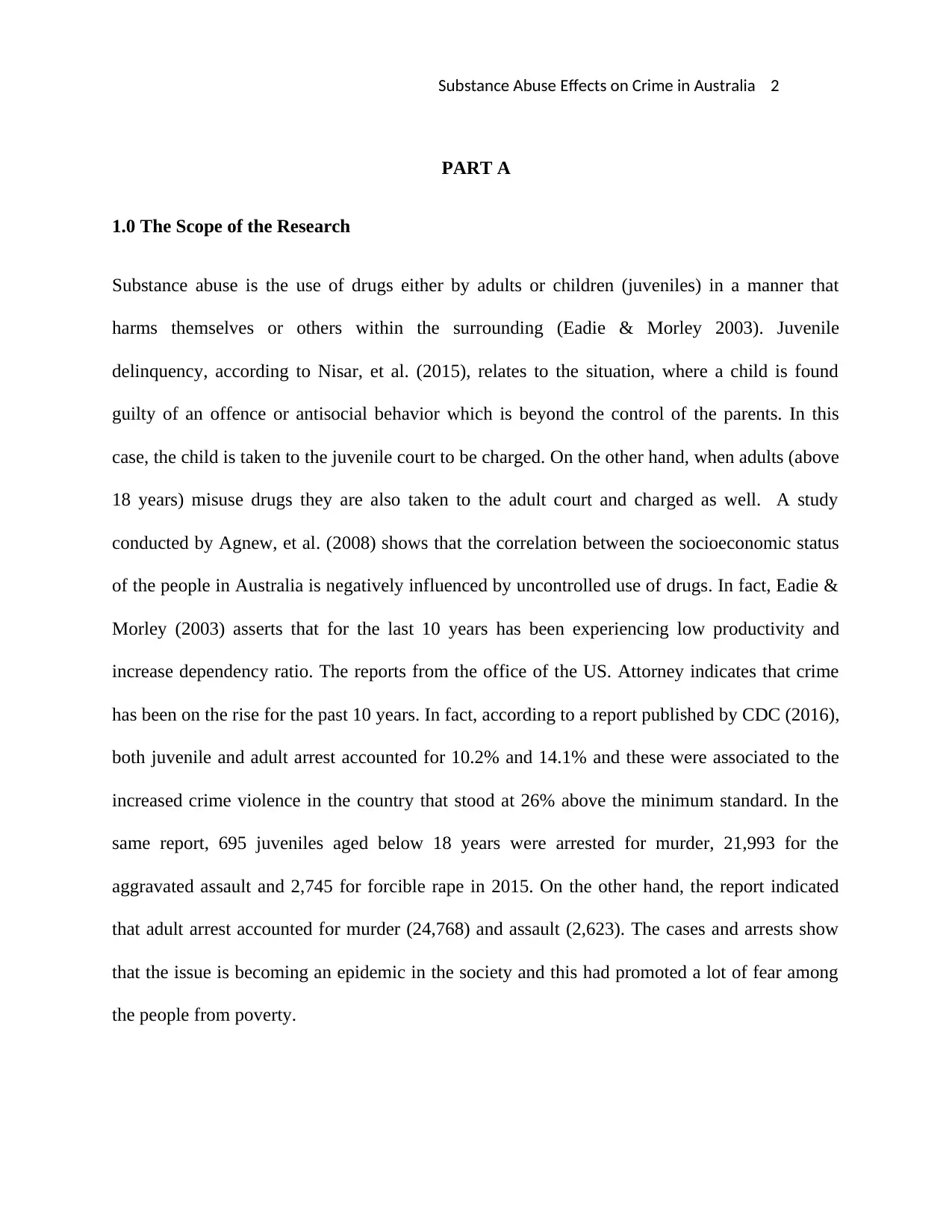
Substance Abuse Effects on Crime in Australia 2
PART A
1.0 The Scope of the Research
Substance abuse is the use of drugs either by adults or children (juveniles) in a manner that
harms themselves or others within the surrounding (Eadie & Morley 2003). Juvenile
delinquency, according to Nisar, et al. (2015), relates to the situation, where a child is found
guilty of an offence or antisocial behavior which is beyond the control of the parents. In this
case, the child is taken to the juvenile court to be charged. On the other hand, when adults (above
18 years) misuse drugs they are also taken to the adult court and charged as well. A study
conducted by Agnew, et al. (2008) shows that the correlation between the socioeconomic status
of the people in Australia is negatively influenced by uncontrolled use of drugs. In fact, Eadie &
Morley (2003) asserts that for the last 10 years has been experiencing low productivity and
increase dependency ratio. The reports from the office of the US. Attorney indicates that crime
has been on the rise for the past 10 years. In fact, according to a report published by CDC (2016),
both juvenile and adult arrest accounted for 10.2% and 14.1% and these were associated to the
increased crime violence in the country that stood at 26% above the minimum standard. In the
same report, 695 juveniles aged below 18 years were arrested for murder, 21,993 for the
aggravated assault and 2,745 for forcible rape in 2015. On the other hand, the report indicated
that adult arrest accounted for murder (24,768) and assault (2,623). The cases and arrests show
that the issue is becoming an epidemic in the society and this had promoted a lot of fear among
the people from poverty.
PART A
1.0 The Scope of the Research
Substance abuse is the use of drugs either by adults or children (juveniles) in a manner that
harms themselves or others within the surrounding (Eadie & Morley 2003). Juvenile
delinquency, according to Nisar, et al. (2015), relates to the situation, where a child is found
guilty of an offence or antisocial behavior which is beyond the control of the parents. In this
case, the child is taken to the juvenile court to be charged. On the other hand, when adults (above
18 years) misuse drugs they are also taken to the adult court and charged as well. A study
conducted by Agnew, et al. (2008) shows that the correlation between the socioeconomic status
of the people in Australia is negatively influenced by uncontrolled use of drugs. In fact, Eadie &
Morley (2003) asserts that for the last 10 years has been experiencing low productivity and
increase dependency ratio. The reports from the office of the US. Attorney indicates that crime
has been on the rise for the past 10 years. In fact, according to a report published by CDC (2016),
both juvenile and adult arrest accounted for 10.2% and 14.1% and these were associated to the
increased crime violence in the country that stood at 26% above the minimum standard. In the
same report, 695 juveniles aged below 18 years were arrested for murder, 21,993 for the
aggravated assault and 2,745 for forcible rape in 2015. On the other hand, the report indicated
that adult arrest accounted for murder (24,768) and assault (2,623). The cases and arrests show
that the issue is becoming an epidemic in the society and this had promoted a lot of fear among
the people from poverty.
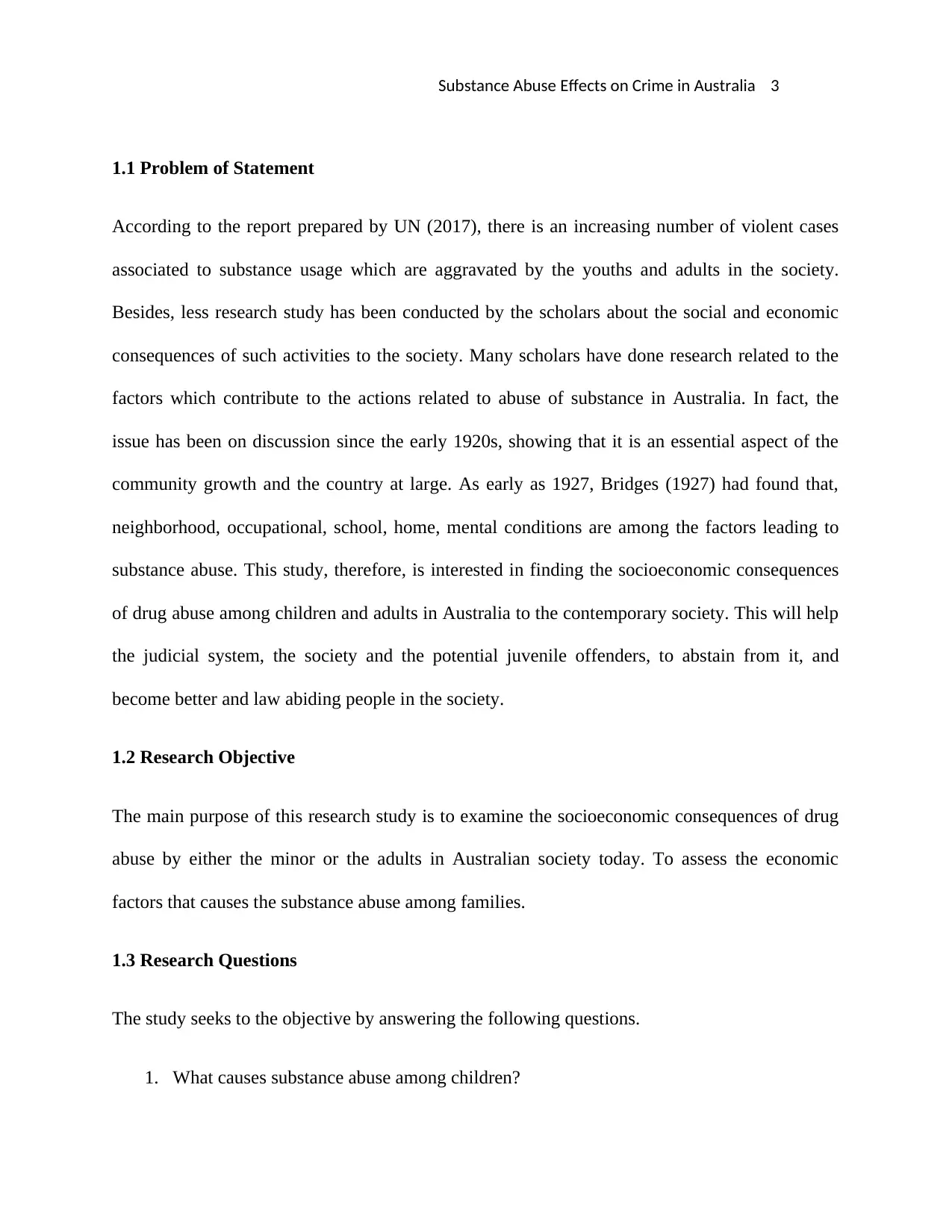
Substance Abuse Effects on Crime in Australia 3
1.1 Problem of Statement
According to the report prepared by UN (2017), there is an increasing number of violent cases
associated to substance usage which are aggravated by the youths and adults in the society.
Besides, less research study has been conducted by the scholars about the social and economic
consequences of such activities to the society. Many scholars have done research related to the
factors which contribute to the actions related to abuse of substance in Australia. In fact, the
issue has been on discussion since the early 1920s, showing that it is an essential aspect of the
community growth and the country at large. As early as 1927, Bridges (1927) had found that,
neighborhood, occupational, school, home, mental conditions are among the factors leading to
substance abuse. This study, therefore, is interested in finding the socioeconomic consequences
of drug abuse among children and adults in Australia to the contemporary society. This will help
the judicial system, the society and the potential juvenile offenders, to abstain from it, and
become better and law abiding people in the society.
1.2 Research Objective
The main purpose of this research study is to examine the socioeconomic consequences of drug
abuse by either the minor or the adults in Australian society today. To assess the economic
factors that causes the substance abuse among families.
1.3 Research Questions
The study seeks to the objective by answering the following questions.
1. What causes substance abuse among children?
1.1 Problem of Statement
According to the report prepared by UN (2017), there is an increasing number of violent cases
associated to substance usage which are aggravated by the youths and adults in the society.
Besides, less research study has been conducted by the scholars about the social and economic
consequences of such activities to the society. Many scholars have done research related to the
factors which contribute to the actions related to abuse of substance in Australia. In fact, the
issue has been on discussion since the early 1920s, showing that it is an essential aspect of the
community growth and the country at large. As early as 1927, Bridges (1927) had found that,
neighborhood, occupational, school, home, mental conditions are among the factors leading to
substance abuse. This study, therefore, is interested in finding the socioeconomic consequences
of drug abuse among children and adults in Australia to the contemporary society. This will help
the judicial system, the society and the potential juvenile offenders, to abstain from it, and
become better and law abiding people in the society.
1.2 Research Objective
The main purpose of this research study is to examine the socioeconomic consequences of drug
abuse by either the minor or the adults in Australian society today. To assess the economic
factors that causes the substance abuse among families.
1.3 Research Questions
The study seeks to the objective by answering the following questions.
1. What causes substance abuse among children?
⊘ This is a preview!⊘
Do you want full access?
Subscribe today to unlock all pages.

Trusted by 1+ million students worldwide
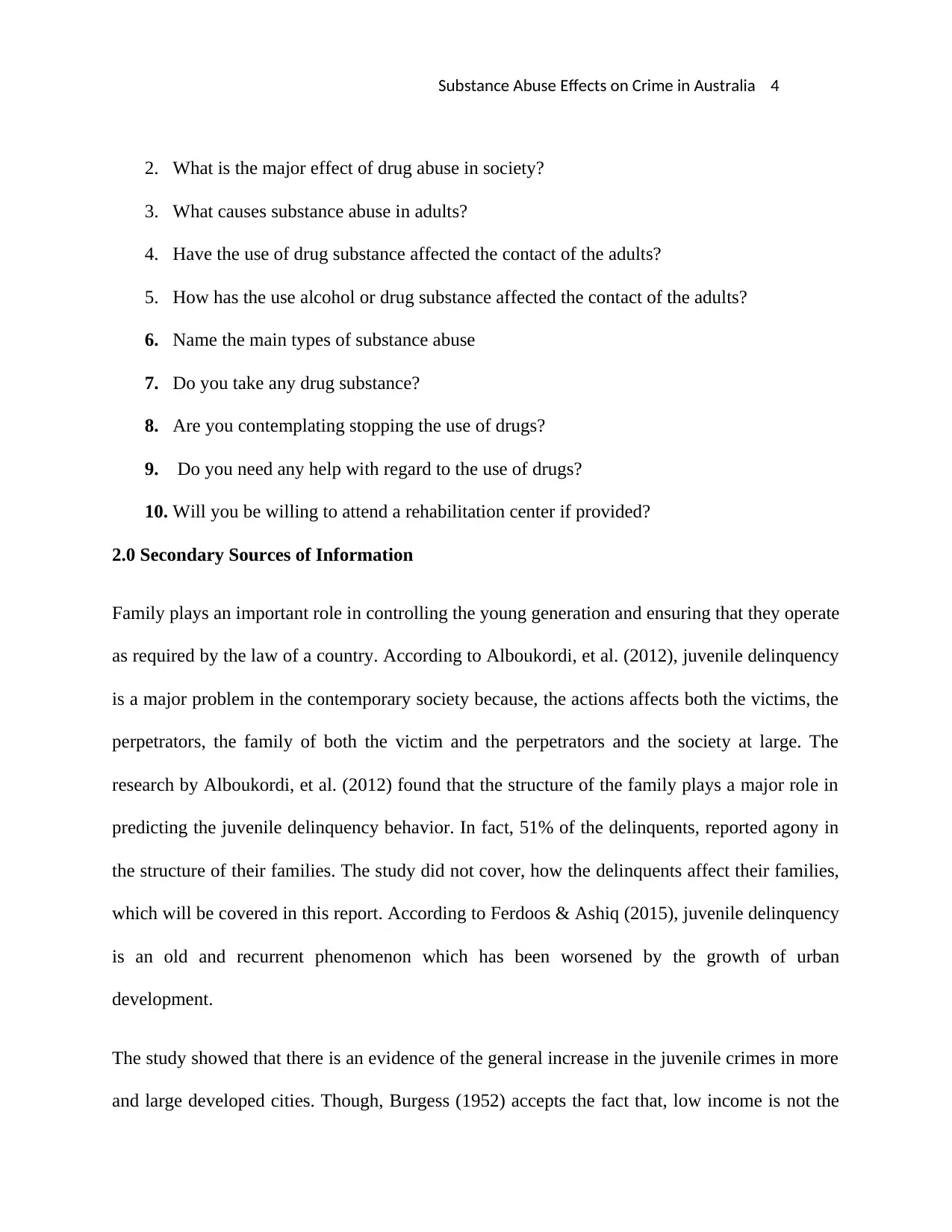
Substance Abuse Effects on Crime in Australia 4
2. What is the major effect of drug abuse in society?
3. What causes substance abuse in adults?
4. Have the use of drug substance affected the contact of the adults?
5. How has the use alcohol or drug substance affected the contact of the adults?
6. Name the main types of substance abuse
7. Do you take any drug substance?
8. Are you contemplating stopping the use of drugs?
9. Do you need any help with regard to the use of drugs?
10. Will you be willing to attend a rehabilitation center if provided?
2.0 Secondary Sources of Information
Family plays an important role in controlling the young generation and ensuring that they operate
as required by the law of a country. According to Alboukordi, et al. (2012), juvenile delinquency
is a major problem in the contemporary society because, the actions affects both the victims, the
perpetrators, the family of both the victim and the perpetrators and the society at large. The
research by Alboukordi, et al. (2012) found that the structure of the family plays a major role in
predicting the juvenile delinquency behavior. In fact, 51% of the delinquents, reported agony in
the structure of their families. The study did not cover, how the delinquents affect their families,
which will be covered in this report. According to Ferdoos & Ashiq (2015), juvenile delinquency
is an old and recurrent phenomenon which has been worsened by the growth of urban
development.
The study showed that there is an evidence of the general increase in the juvenile crimes in more
and large developed cities. Though, Burgess (1952) accepts the fact that, low income is not the
2. What is the major effect of drug abuse in society?
3. What causes substance abuse in adults?
4. Have the use of drug substance affected the contact of the adults?
5. How has the use alcohol or drug substance affected the contact of the adults?
6. Name the main types of substance abuse
7. Do you take any drug substance?
8. Are you contemplating stopping the use of drugs?
9. Do you need any help with regard to the use of drugs?
10. Will you be willing to attend a rehabilitation center if provided?
2.0 Secondary Sources of Information
Family plays an important role in controlling the young generation and ensuring that they operate
as required by the law of a country. According to Alboukordi, et al. (2012), juvenile delinquency
is a major problem in the contemporary society because, the actions affects both the victims, the
perpetrators, the family of both the victim and the perpetrators and the society at large. The
research by Alboukordi, et al. (2012) found that the structure of the family plays a major role in
predicting the juvenile delinquency behavior. In fact, 51% of the delinquents, reported agony in
the structure of their families. The study did not cover, how the delinquents affect their families,
which will be covered in this report. According to Ferdoos & Ashiq (2015), juvenile delinquency
is an old and recurrent phenomenon which has been worsened by the growth of urban
development.
The study showed that there is an evidence of the general increase in the juvenile crimes in more
and large developed cities. Though, Burgess (1952) accepts the fact that, low income is not the
Paraphrase This Document
Need a fresh take? Get an instant paraphrase of this document with our AI Paraphraser
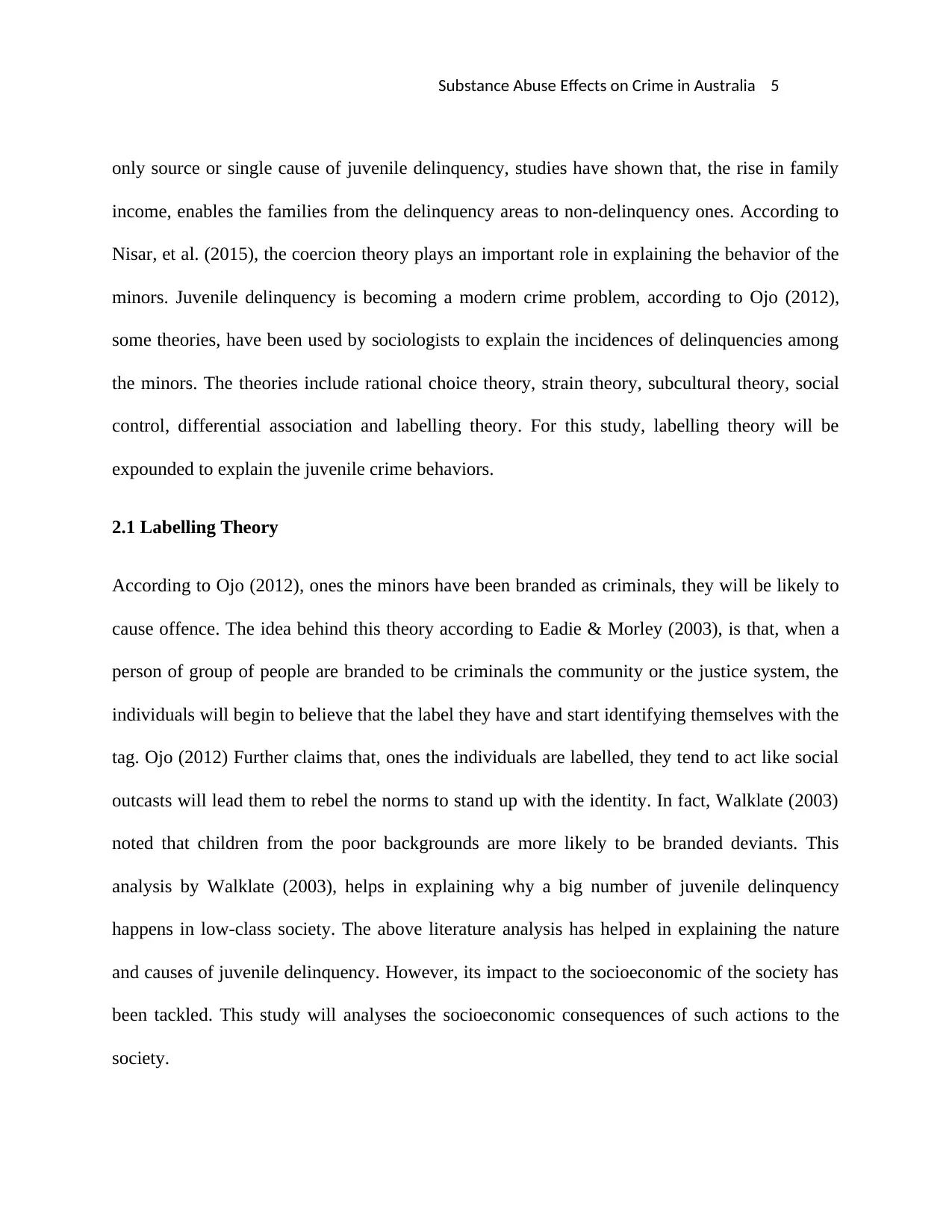
Substance Abuse Effects on Crime in Australia 5
only source or single cause of juvenile delinquency, studies have shown that, the rise in family
income, enables the families from the delinquency areas to non-delinquency ones. According to
Nisar, et al. (2015), the coercion theory plays an important role in explaining the behavior of the
minors. Juvenile delinquency is becoming a modern crime problem, according to Ojo (2012),
some theories, have been used by sociologists to explain the incidences of delinquencies among
the minors. The theories include rational choice theory, strain theory, subcultural theory, social
control, differential association and labelling theory. For this study, labelling theory will be
expounded to explain the juvenile crime behaviors.
2.1 Labelling Theory
According to Ojo (2012), ones the minors have been branded as criminals, they will be likely to
cause offence. The idea behind this theory according to Eadie & Morley (2003), is that, when a
person of group of people are branded to be criminals the community or the justice system, the
individuals will begin to believe that the label they have and start identifying themselves with the
tag. Ojo (2012) Further claims that, ones the individuals are labelled, they tend to act like social
outcasts will lead them to rebel the norms to stand up with the identity. In fact, Walklate (2003)
noted that children from the poor backgrounds are more likely to be branded deviants. This
analysis by Walklate (2003), helps in explaining why a big number of juvenile delinquency
happens in low-class society. The above literature analysis has helped in explaining the nature
and causes of juvenile delinquency. However, its impact to the socioeconomic of the society has
been tackled. This study will analyses the socioeconomic consequences of such actions to the
society.
only source or single cause of juvenile delinquency, studies have shown that, the rise in family
income, enables the families from the delinquency areas to non-delinquency ones. According to
Nisar, et al. (2015), the coercion theory plays an important role in explaining the behavior of the
minors. Juvenile delinquency is becoming a modern crime problem, according to Ojo (2012),
some theories, have been used by sociologists to explain the incidences of delinquencies among
the minors. The theories include rational choice theory, strain theory, subcultural theory, social
control, differential association and labelling theory. For this study, labelling theory will be
expounded to explain the juvenile crime behaviors.
2.1 Labelling Theory
According to Ojo (2012), ones the minors have been branded as criminals, they will be likely to
cause offence. The idea behind this theory according to Eadie & Morley (2003), is that, when a
person of group of people are branded to be criminals the community or the justice system, the
individuals will begin to believe that the label they have and start identifying themselves with the
tag. Ojo (2012) Further claims that, ones the individuals are labelled, they tend to act like social
outcasts will lead them to rebel the norms to stand up with the identity. In fact, Walklate (2003)
noted that children from the poor backgrounds are more likely to be branded deviants. This
analysis by Walklate (2003), helps in explaining why a big number of juvenile delinquency
happens in low-class society. The above literature analysis has helped in explaining the nature
and causes of juvenile delinquency. However, its impact to the socioeconomic of the society has
been tackled. This study will analyses the socioeconomic consequences of such actions to the
society.
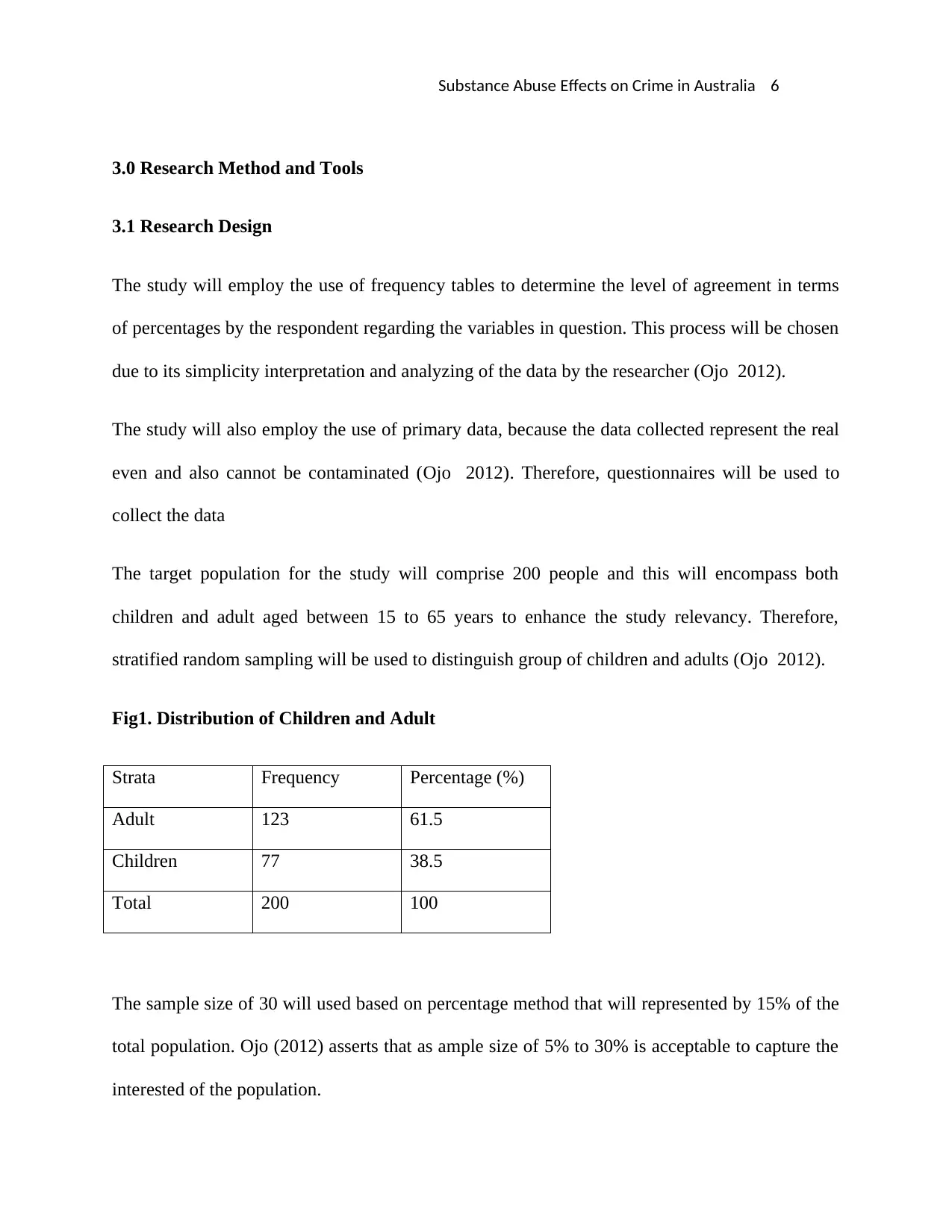
Substance Abuse Effects on Crime in Australia 6
3.0 Research Method and Tools
3.1 Research Design
The study will employ the use of frequency tables to determine the level of agreement in terms
of percentages by the respondent regarding the variables in question. This process will be chosen
due to its simplicity interpretation and analyzing of the data by the researcher (Ojo 2012).
The study will also employ the use of primary data, because the data collected represent the real
even and also cannot be contaminated (Ojo 2012). Therefore, questionnaires will be used to
collect the data
The target population for the study will comprise 200 people and this will encompass both
children and adult aged between 15 to 65 years to enhance the study relevancy. Therefore,
stratified random sampling will be used to distinguish group of children and adults (Ojo 2012).
Fig1. Distribution of Children and Adult
Strata Frequency Percentage (%)
Adult 123 61.5
Children 77 38.5
Total 200 100
The sample size of 30 will used based on percentage method that will represented by 15% of the
total population. Ojo (2012) asserts that as ample size of 5% to 30% is acceptable to capture the
interested of the population.
3.0 Research Method and Tools
3.1 Research Design
The study will employ the use of frequency tables to determine the level of agreement in terms
of percentages by the respondent regarding the variables in question. This process will be chosen
due to its simplicity interpretation and analyzing of the data by the researcher (Ojo 2012).
The study will also employ the use of primary data, because the data collected represent the real
even and also cannot be contaminated (Ojo 2012). Therefore, questionnaires will be used to
collect the data
The target population for the study will comprise 200 people and this will encompass both
children and adult aged between 15 to 65 years to enhance the study relevancy. Therefore,
stratified random sampling will be used to distinguish group of children and adults (Ojo 2012).
Fig1. Distribution of Children and Adult
Strata Frequency Percentage (%)
Adult 123 61.5
Children 77 38.5
Total 200 100
The sample size of 30 will used based on percentage method that will represented by 15% of the
total population. Ojo (2012) asserts that as ample size of 5% to 30% is acceptable to capture the
interested of the population.
⊘ This is a preview!⊘
Do you want full access?
Subscribe today to unlock all pages.

Trusted by 1+ million students worldwide
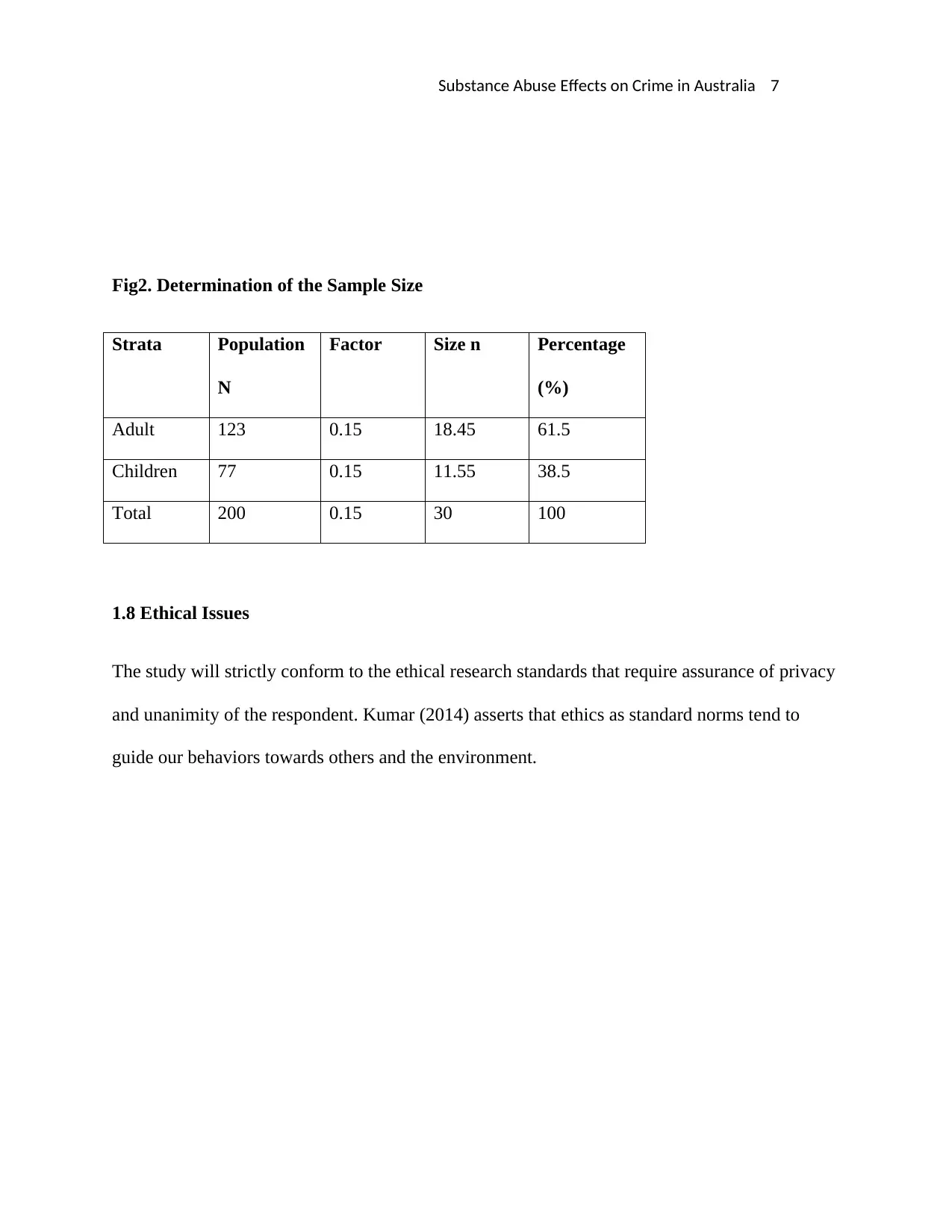
Substance Abuse Effects on Crime in Australia 7
Fig2. Determination of the Sample Size
Strata Population
N
Factor Size n Percentage
(%)
Adult 123 0.15 18.45 61.5
Children 77 0.15 11.55 38.5
Total 200 0.15 30 100
1.8 Ethical Issues
The study will strictly conform to the ethical research standards that require assurance of privacy
and unanimity of the respondent. Kumar (2014) asserts that ethics as standard norms tend to
guide our behaviors towards others and the environment.
Fig2. Determination of the Sample Size
Strata Population
N
Factor Size n Percentage
(%)
Adult 123 0.15 18.45 61.5
Children 77 0.15 11.55 38.5
Total 200 0.15 30 100
1.8 Ethical Issues
The study will strictly conform to the ethical research standards that require assurance of privacy
and unanimity of the respondent. Kumar (2014) asserts that ethics as standard norms tend to
guide our behaviors towards others and the environment.
Paraphrase This Document
Need a fresh take? Get an instant paraphrase of this document with our AI Paraphraser
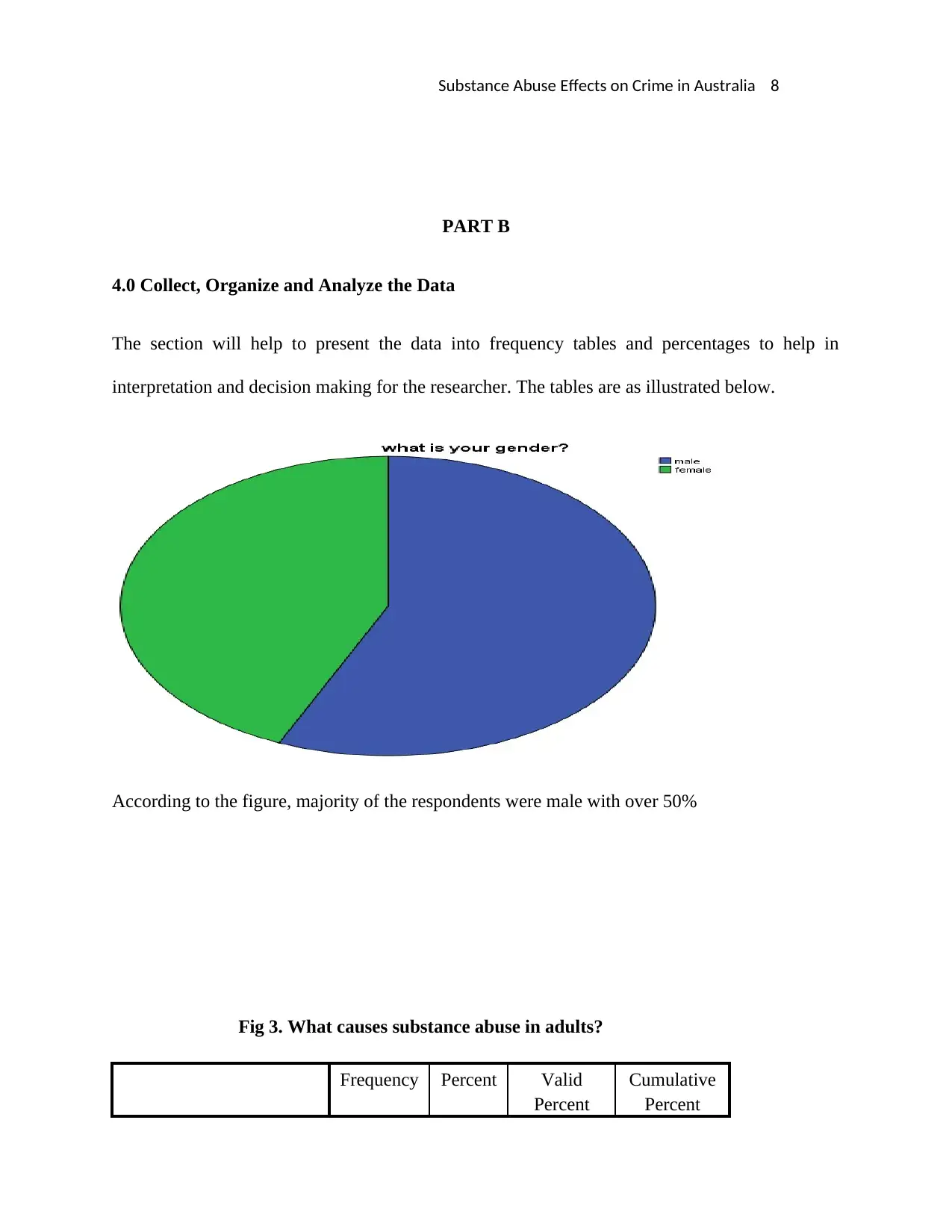
Substance Abuse Effects on Crime in Australia 8
PART B
4.0 Collect, Organize and Analyze the Data
The section will help to present the data into frequency tables and percentages to help in
interpretation and decision making for the researcher. The tables are as illustrated below.
According to the figure, majority of the respondents were male with over 50%
Fig 3. What causes substance abuse in adults?
Frequency Percent Valid
Percent
Cumulative
Percent
PART B
4.0 Collect, Organize and Analyze the Data
The section will help to present the data into frequency tables and percentages to help in
interpretation and decision making for the researcher. The tables are as illustrated below.
According to the figure, majority of the respondents were male with over 50%
Fig 3. What causes substance abuse in adults?
Frequency Percent Valid
Percent
Cumulative
Percent
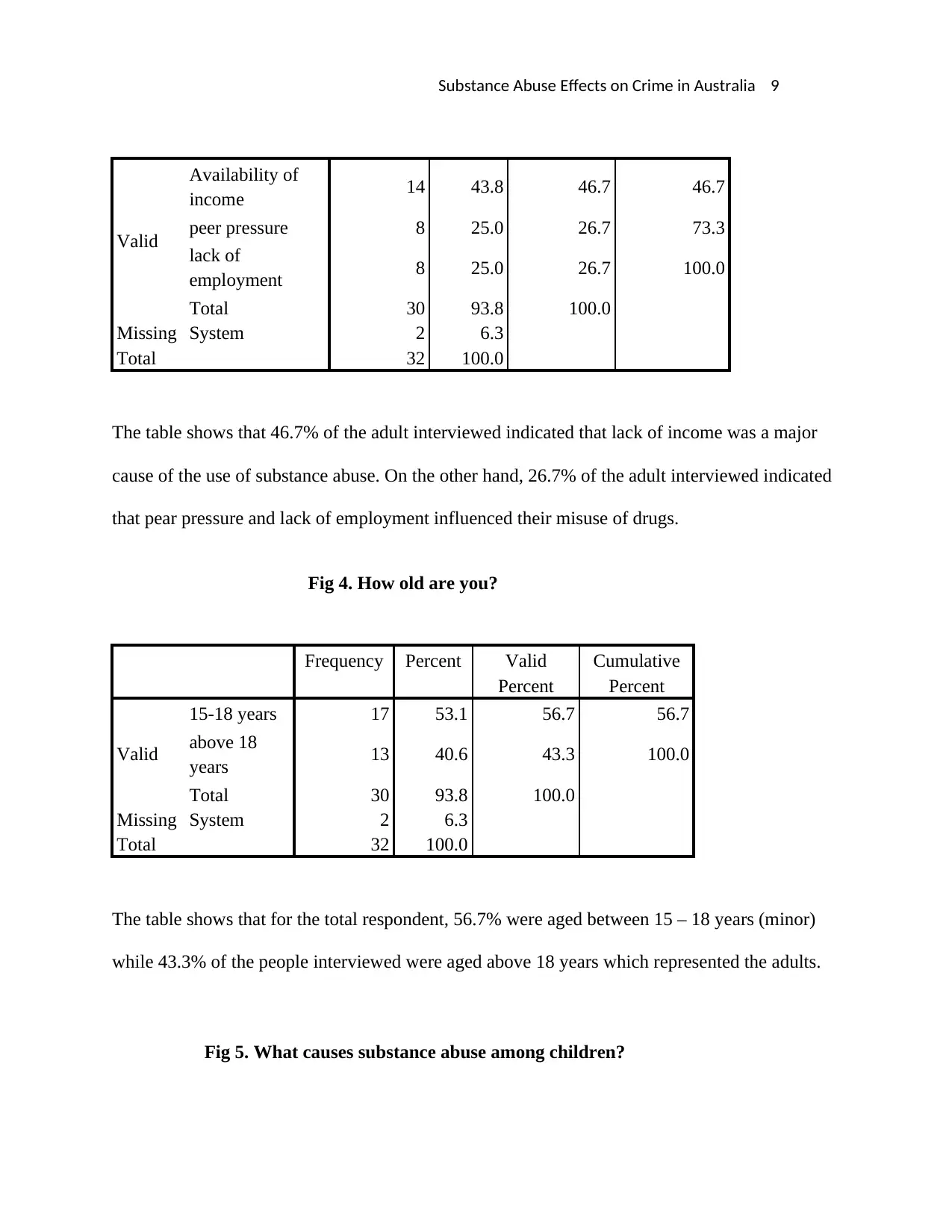
Substance Abuse Effects on Crime in Australia 9
Valid
Availability of
income 14 43.8 46.7 46.7
peer pressure 8 25.0 26.7 73.3
lack of
employment 8 25.0 26.7 100.0
Total 30 93.8 100.0
Missing System 2 6.3
Total 32 100.0
The table shows that 46.7% of the adult interviewed indicated that lack of income was a major
cause of the use of substance abuse. On the other hand, 26.7% of the adult interviewed indicated
that pear pressure and lack of employment influenced their misuse of drugs.
Fig 4. How old are you?
Frequency Percent Valid
Percent
Cumulative
Percent
Valid
15-18 years 17 53.1 56.7 56.7
above 18
years 13 40.6 43.3 100.0
Total 30 93.8 100.0
Missing System 2 6.3
Total 32 100.0
The table shows that for the total respondent, 56.7% were aged between 15 – 18 years (minor)
while 43.3% of the people interviewed were aged above 18 years which represented the adults.
Fig 5. What causes substance abuse among children?
Valid
Availability of
income 14 43.8 46.7 46.7
peer pressure 8 25.0 26.7 73.3
lack of
employment 8 25.0 26.7 100.0
Total 30 93.8 100.0
Missing System 2 6.3
Total 32 100.0
The table shows that 46.7% of the adult interviewed indicated that lack of income was a major
cause of the use of substance abuse. On the other hand, 26.7% of the adult interviewed indicated
that pear pressure and lack of employment influenced their misuse of drugs.
Fig 4. How old are you?
Frequency Percent Valid
Percent
Cumulative
Percent
Valid
15-18 years 17 53.1 56.7 56.7
above 18
years 13 40.6 43.3 100.0
Total 30 93.8 100.0
Missing System 2 6.3
Total 32 100.0
The table shows that for the total respondent, 56.7% were aged between 15 – 18 years (minor)
while 43.3% of the people interviewed were aged above 18 years which represented the adults.
Fig 5. What causes substance abuse among children?
⊘ This is a preview!⊘
Do you want full access?
Subscribe today to unlock all pages.

Trusted by 1+ million students worldwide
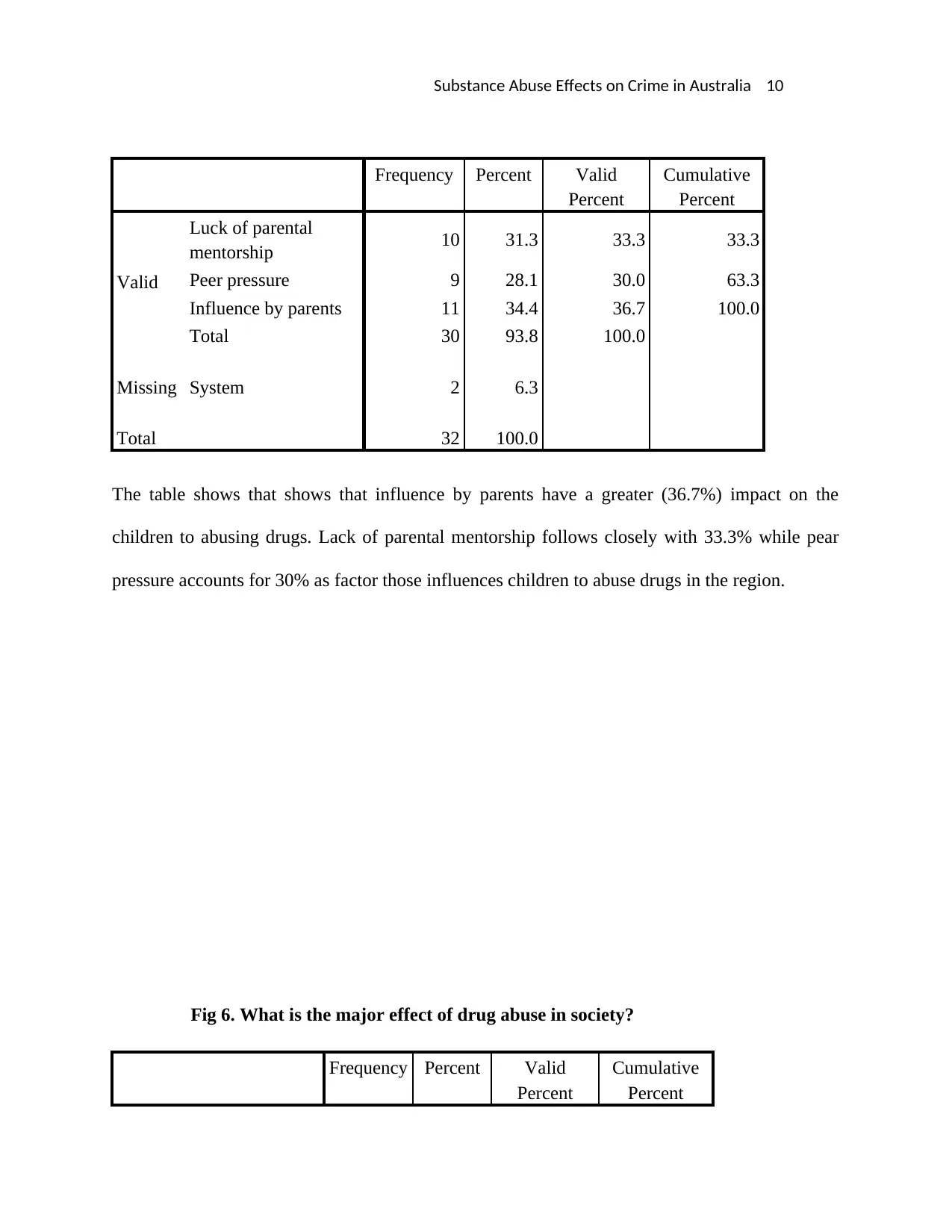
Substance Abuse Effects on Crime in Australia 10
Frequency Percent Valid
Percent
Cumulative
Percent
Valid
Luck of parental
mentorship 10 31.3 33.3 33.3
Peer pressure 9 28.1 30.0 63.3
Influence by parents 11 34.4 36.7 100.0
Total 30 93.8 100.0
Missing System 2 6.3
Total 32 100.0
The table shows that shows that influence by parents have a greater (36.7%) impact on the
children to abusing drugs. Lack of parental mentorship follows closely with 33.3% while pear
pressure accounts for 30% as factor those influences children to abuse drugs in the region.
Fig 6. What is the major effect of drug abuse in society?
Frequency Percent Valid
Percent
Cumulative
Percent
Frequency Percent Valid
Percent
Cumulative
Percent
Valid
Luck of parental
mentorship 10 31.3 33.3 33.3
Peer pressure 9 28.1 30.0 63.3
Influence by parents 11 34.4 36.7 100.0
Total 30 93.8 100.0
Missing System 2 6.3
Total 32 100.0
The table shows that shows that influence by parents have a greater (36.7%) impact on the
children to abusing drugs. Lack of parental mentorship follows closely with 33.3% while pear
pressure accounts for 30% as factor those influences children to abuse drugs in the region.
Fig 6. What is the major effect of drug abuse in society?
Frequency Percent Valid
Percent
Cumulative
Percent
Paraphrase This Document
Need a fresh take? Get an instant paraphrase of this document with our AI Paraphraser
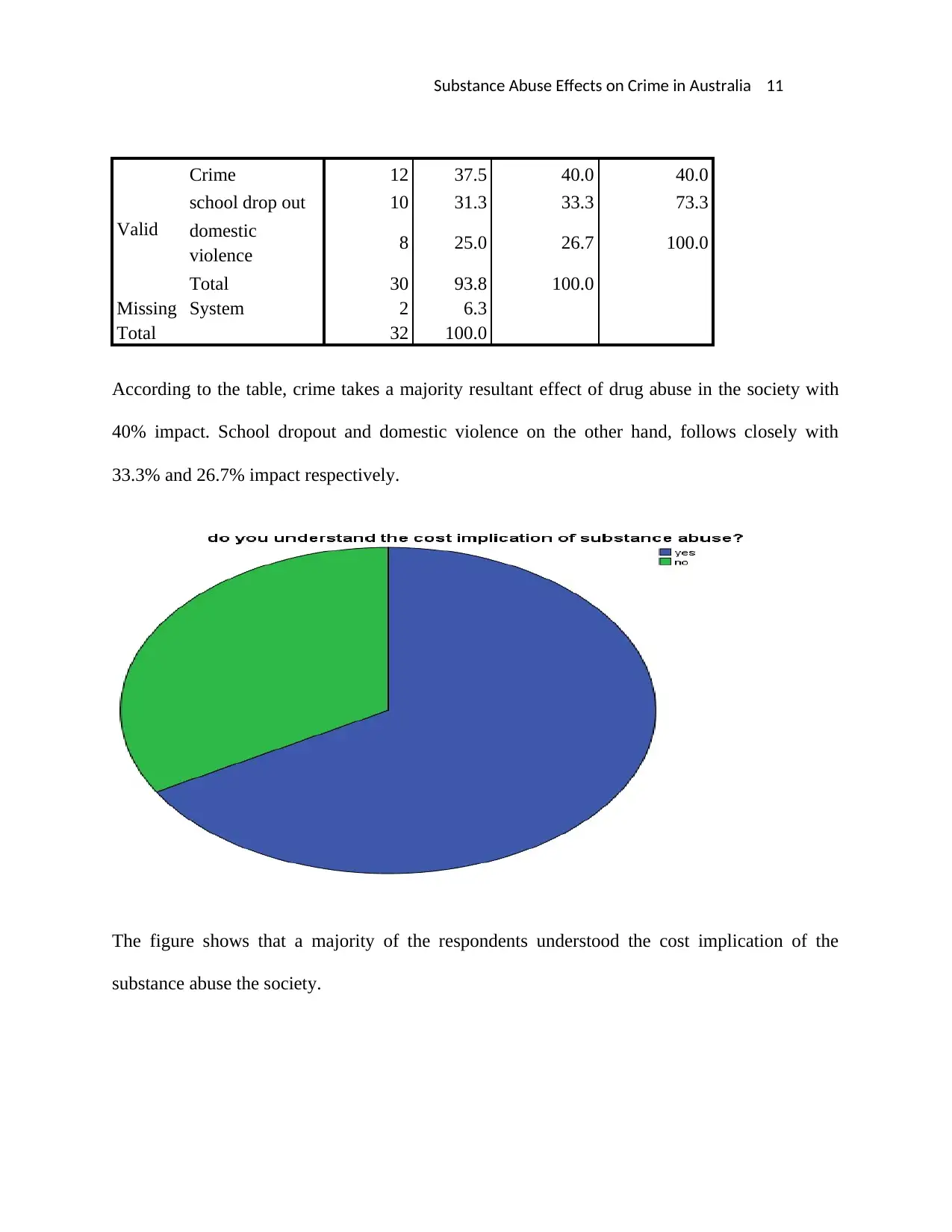
Substance Abuse Effects on Crime in Australia 11
Valid
Crime 12 37.5 40.0 40.0
school drop out 10 31.3 33.3 73.3
domestic
violence 8 25.0 26.7 100.0
Total 30 93.8 100.0
Missing System 2 6.3
Total 32 100.0
According to the table, crime takes a majority resultant effect of drug abuse in the society with
40% impact. School dropout and domestic violence on the other hand, follows closely with
33.3% and 26.7% impact respectively.
The figure shows that a majority of the respondents understood the cost implication of the
substance abuse the society.
Valid
Crime 12 37.5 40.0 40.0
school drop out 10 31.3 33.3 73.3
domestic
violence 8 25.0 26.7 100.0
Total 30 93.8 100.0
Missing System 2 6.3
Total 32 100.0
According to the table, crime takes a majority resultant effect of drug abuse in the society with
40% impact. School dropout and domestic violence on the other hand, follows closely with
33.3% and 26.7% impact respectively.
The figure shows that a majority of the respondents understood the cost implication of the
substance abuse the society.
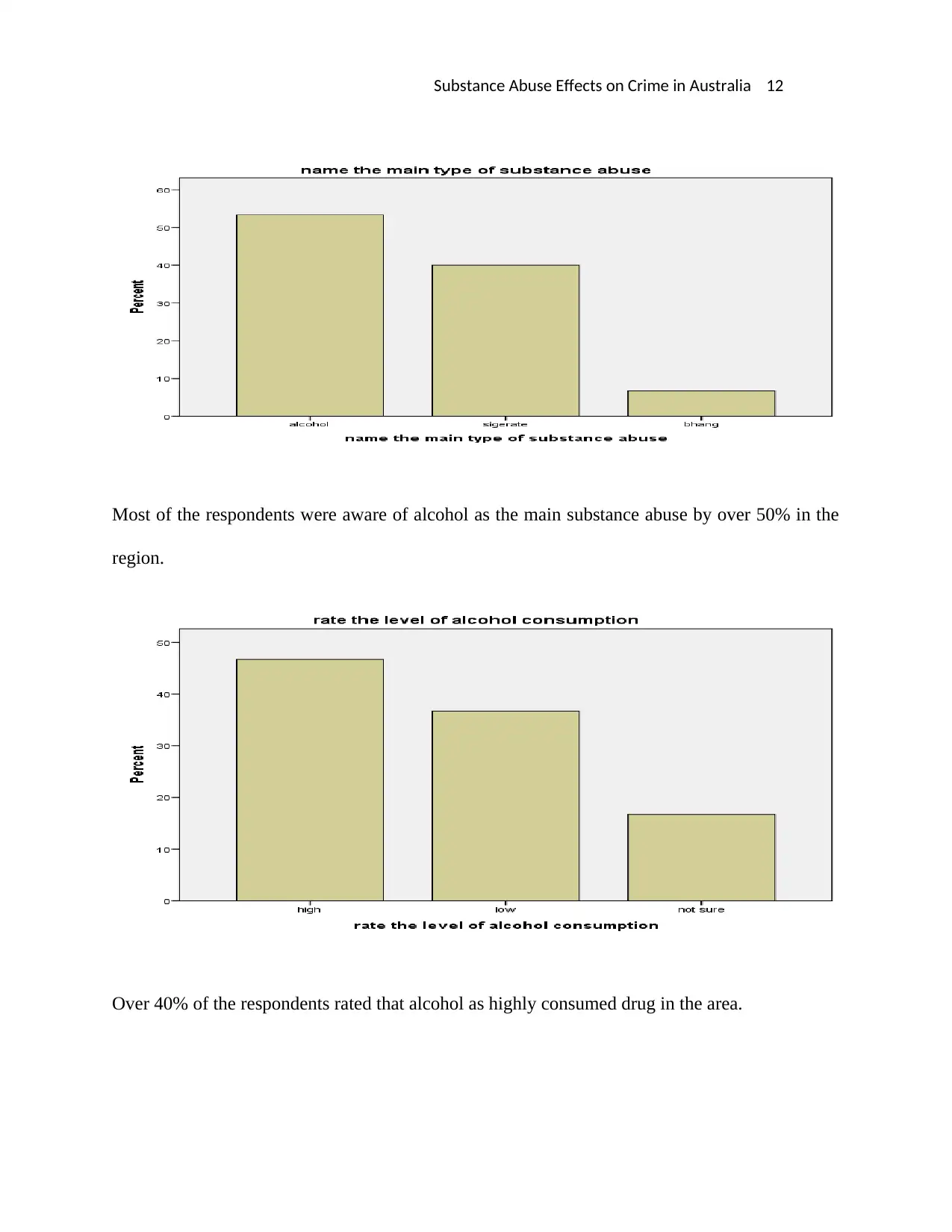
Substance Abuse Effects on Crime in Australia 12
Most of the respondents were aware of alcohol as the main substance abuse by over 50% in the
region.
Over 40% of the respondents rated that alcohol as highly consumed drug in the area.
Most of the respondents were aware of alcohol as the main substance abuse by over 50% in the
region.
Over 40% of the respondents rated that alcohol as highly consumed drug in the area.
⊘ This is a preview!⊘
Do you want full access?
Subscribe today to unlock all pages.

Trusted by 1+ million students worldwide
1 out of 21
Your All-in-One AI-Powered Toolkit for Academic Success.
+13062052269
info@desklib.com
Available 24*7 on WhatsApp / Email
![[object Object]](/_next/static/media/star-bottom.7253800d.svg)
Unlock your academic potential
Copyright © 2020–2025 A2Z Services. All Rights Reserved. Developed and managed by ZUCOL.